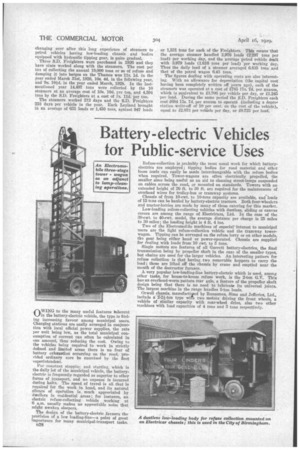Battery-electric Vehicles for Public-service Uses
Page 98

If you've noticed an error in this article please click here to report it so we can fix it.
OWING to the many useful features inherent in the battery-electric vehicle, the type is finding increasing favour among municipal users. Charging stations are easily arranged in conjunction with local official power supplies, the rate per unit being low, as the total municipal consumption of current can often be calculated in one amount, thus reducing the cost. Owing to the vehicles being required to work in strictly defined and limited areas there is no fear of battery exhaustion occurring on the road, provided ordinary care be exercised by the fleet superintendent.
For constant stoppins and starting, which is the daily lot of the municipal vehicle, the batteryelectric. is frequently regarded as superior to other forms of transport, and no expense is iucurred during halts. The speed of travel is all that is required for the work in hand, and its natural silence of operation is much appreciated bY dwellers in residential areas: for instance, an electric refuse-collecting vehicle working at 6 a.m. usually makes no appreciable noise that might awaken sleepers, The design of the battery-electric favours the provision of a low loading-line---a point of great importance for many municipal-transport tasks. D28 Refuse-collection is probably the most usual work for which batteryelectrics are employed; tippiug bodies for road material and other loose loads can easily be made interchangeable with the refuse bodies when required. Tower-wagons are often electrically propelled, the smaller sizes being useful as an aid to cleaning street-lamps suspended on cables across the road, or mounted on standards. Towers with an extended height of 20 ft. to 30 ft. are required for the maintenance of overhead wires for trolley-bus or tramway systems.
Chassis of from 10-cwt. to 10-tons capacity are available, and loads of 15 tens can be hauled by battery-electric tractors. Both four-wheelers and tractor-lorries are made by many of those catering for this market.
Low-loading refuse-collecting vehicles with dustless, sliding or canvas covers are among the range of Electricars, Ltd. In the ease of the 30-cwt. to 40-ewt. model, the average distance per charge is 25 miles to 30 miles; the loading height is 4 ft. 4 ins.
Two of the neeteomoLile machines of especial Interest to municipal users are the light refuse-collection vehicle and the tramway towerwagon. Tipping can be arrtnged on the refuse lorry or on other models, the gear being either hand or power-operated. Chassis are supplied for dealing with loads from 10 cwt. to 5 tons.
Single motors are features of all Garrett battery-electrics, the final transmission being by propeller shaft in the case of the smaller types, but chains are used for the larger vehicles. An interesting pattern for refuse collection is that having two removable hoppers to carry the load; these are lifted off the chassis by crane and emptied near the month of the destructor furnace.
A very popular low-loading-line battery-electric which is used, among other tasks, for house-to-house refuse work, is the 2-ton G.V. This has an overhead-worm pattern rear axle, a feature of the propeller shaft design being that there is no need to lubricate its universal joints. The largest machine in the range handles 5-ton loads.
Orwell chassis, manufacttged by Ransomes, Sims and Jefferies, Ltd., include a 2-2i-ton type with two motors driving the front wheels, a vehicle of similar capacity with rear-wheel drive, also two other machines with load capacities of 4 tons and 5 tons respectively.








































































































































































































